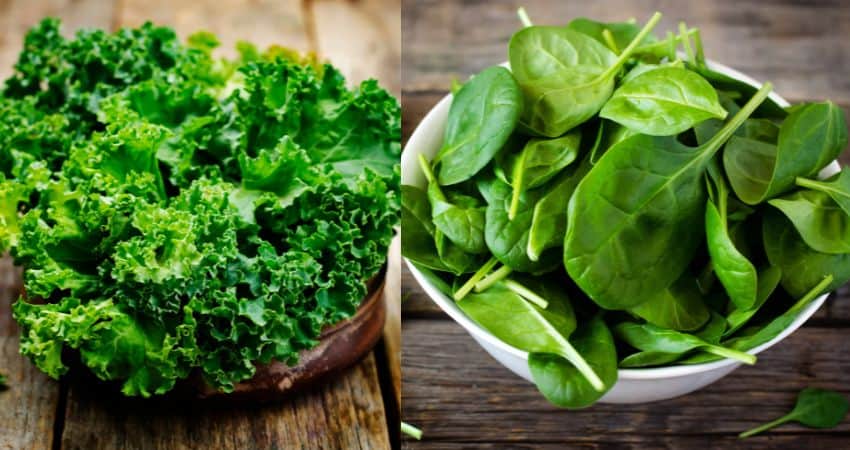Kale vs Spinach Benefits
Many people choose to consume kale and spinach due to their numerous health benefits. When comparing the two vegetables, is one better for benefits than the other?
Kale and spinach contain many of the same nutrients in similar amounts. Both nutrient dense vegetables are equally beneficial and should be included as part of a well-rounded, healthy diet.
This article will take a close look at the health benefits offered by each each vegetable.
Kale vs Spinach Benefits
During my health coaching sessions, many of my clients ask me about the benefits of vegetables including kale and spinach. I also consume both vegetables almost daily. For this reason I have researched this topic prior to and during writing this article. Let’s examine kale benefits first.

Kale Benefits
Dietary Fiber
- Kale provides 86% more fiber per 100 grams.
Soluble fiber is helpful for many reasons ((National Center for Biotechnology Information: Mechanisms linking dietary fiber, gut microbiota and colon cancer prevention)). What makes fiber soluble is it dissolves in water.
Soluble fiber is known for the following:
- Help overall digestion.
- Helps to have a more regular stool and avoid constipation.
- Manage the blood glucose levels which helps decrease the risk of diabetes.
- Aids greatly in weight management because it allows you to feel full faster and eat less.
Protein
- Kale provides 2% more protein per 100 grams.
Protein is helpful for many reasons ((National Center for Biotechnology Information: Dietary protein intake and human health)). Protein is known for the following:
- Helps to build, repair and maintain muscle.
- Aids in weight management because it allows you to feel full eat less later.
- Can help increase metabolism.
Low levels of protein may result in the following:
- Anemia
- Impaired immunity
- Physical weakness
- Edema
- Vascular dysfunction
Phosphorous
- Kale contains 11% more phosphorous per 100 grams.
Phosphorous has been shown in studies to help with the following:
- Promote healthy nerve conduction.
- Help the body manage and store energy.
- Help the kidneys remove waste.
- Muscle contraction and recovery.
- Promote bone and teeth health.
Calcium
- Kale contains 61% more calcium per 100 grams.
Calcium has been shown in studies beneficial for the following:
- Help the muscles to function properly.
- Helps nerve function.
- Maintain and build strong bones.
In addition, calcium is important for the heart and blood pressure. Harvard Health reports calcium helps maintain blood pressure by helping in the controlling of the relaxing and tightening of blood vessels1.
Vitamin C
Vitamin C acts as an antioxidant and helps with the following:
- Prevent cell damage.
- Increases iron absorption.
- Help maintain health gums.
- Collagen production.
- May help boost the immune system.
- Help heal wounds.
B Vitamins
Of the following B vitamins kale provides a larger percentage of four out of the six.
The B vitamins provided include the following:
- B1 (thiamin)
- B2 (riboflavin)
- B3 (niacin)
- B5
- B6
- B9 (folate)
B vitamins help support the following:
- Digestion.
- Nerve function.
- Brain function.
- Red blood cells.
- Energy levels.
- Cardiovascular disease.

Spinach Benefits
Spinach provides a higher percentage of five of the seven minerals listed in the nutrient table above. The difference in minerals between the two is significant. Therefore, let’s take a close look at the minerals and discuss how they may benefit health.
Magnesium
- Spinach contains 58% more magnesium per 100 grams.
Magnesium helps the body control the following:
- Blood sugar
- Systolic and diastolic blood pressure
- Insomnia
- Nerve function
- Muscle function
In the heart and muscles, magnesium competes with calcium to help the muscles relax after contracting. When the body is low in magnesium, calcium can over stimulate the heart muscle’s cells causing a rapid or irregular heartbeat2.
One reason many people supplement with magnesium in the evening is because it helps calm the whole body including blood vessels.
Magnesium helps keep blood pressure levels stable and balanced. Recent scientific research examined previous studies and concluded magnesium supplementation decreased systolic and diastolic blood pressure3.
Find out if Swiss chard has more nutrients in my article, Spinach vs Swiss Chard: Which is Better? Complete Comparison.

Potassium
- Spinach contains 38% more potassium per 100 grams.
Some medical experts recommend the potassium to sodium ratio of 4:1. Consuming too much sodium or not enough potassium throws off the delicate balance the kidneys need to remove the excess water4.
Potassium helps the body reduce excess fluid and blood pressure5.
According to Harvard Health, a number of studies have shown a connection between low potassium levels and high blood pressure6. The more potassium, the more sodium your body will lose.
Iron
- Spinach contains 41% more iron per 100 grams.
Iron is a necessary part of any healthy diet7. Iron may help with the following:
- Is essential the creation of red blood cells.
- Vital for growth and development.
- Help some hormones remain balanced.
- Help the immune system.
Find out the differences between these two spinach varieties in my comparison article.
Vitamin A & Beta Carotene
- Spinach provides 109% more vitamin A and 96% more beta carotene per 100 grams.
Beta-carotene is a compound present in both vegetables. The body converts beta-carotene into vitamin A. Vitamin A is a powerful antioxidant that can help reduce cellular damage by controlling the negative effects of free radicals8.
An increased number of vitamin A has been shown to fight and prevent cardiovascular disease, which is the leading cause of death in the United States9.
According to scientific studies, vitamin A helps the eyes when it comes to dim light vision and dry eyes ((National Center for Biotechnology Information: Nutrients for the aging eye)).
Find out if which type has more nutrients in my article, Raw Spinach vs Cooked Spinach: Which is Better? A Comparison.
If you have any questions to ask me about this article don’t hesitate to comment below or email us. You can find an email on our contact page.
More Spinach Articles
Cabbage vs Spinach: Which is Better? Let’s Compare
Kale vs Spinach: Which is Better? A Complete Comparison
Spinach vs Broccoli: Which is Better? A Complete Comparison
Frozen Spinach vs Fresh: Which is Better? A Comparison
Arugula vs Spinach: Which is Better? A Complete Comparison
- Harvard Health: Key minerals to help control blood pressure [↩]
- National Institutes of Health: Magnesium [↩]
- National Center for Biotechnology Information: Effect of magnesium supplementation on blood pressure: a meta-analysis [↩]
- National Center for Biotechnology Information: The Effect of the Sodium to Potassium Ratio on Hypertension Prevalence: A Propensity Score Matching Approach [↩]
- American Heart Association: How Potassium Can Help Control High Blood Pressure [↩]
- Harvard Health: Potassium lowers blood pressure [↩]
- National Institutes of Health: Iron [↩]
- National Center for Biotechnology Information: Free radicals, antioxidants and functional foods: Impact on human health [↩]
- National Center for Biotechnology Information: Antioxidant potentials of vitamin A and carotenoids and their relevance to heart disease [↩]
